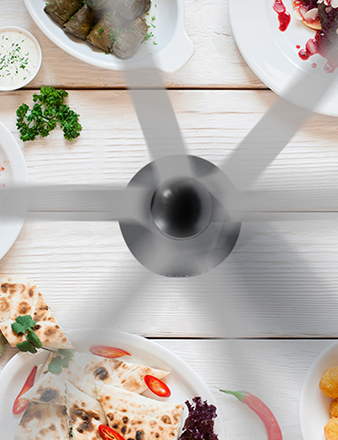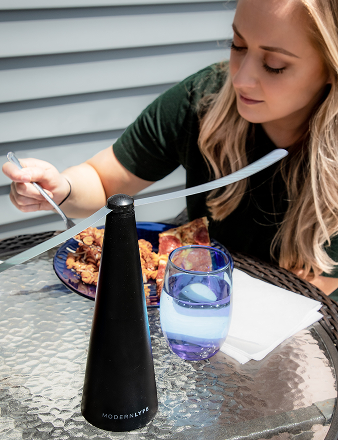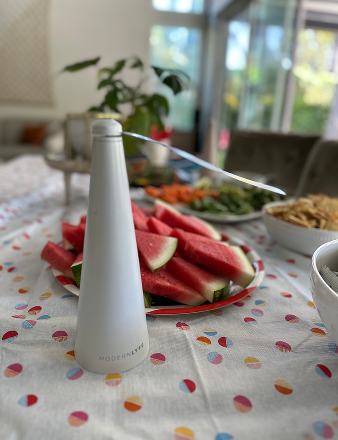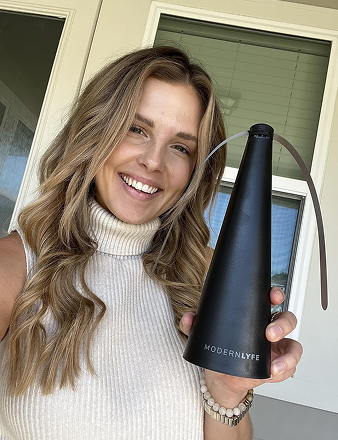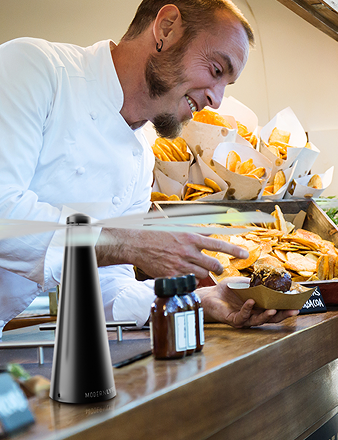Enjoying a meal outdoors means dealing with flies. A fly repellent fan is the simplest, most effective way to keep your space pest-free. This isn't just a fan; it's a smart, chemical-free barrier that keeps flies away without any fuss.
Instead of harsh chemicals or ugly traps, these devices use soft, rotating blades to create a gentle air current. This constant airflow is the key—it disrupts a fly's navigation, creating an invisible shield over your food. It’s a quiet, modern, and powerful defense against one of summer's most persistent pests.
How a Simple Fan Creates a No-Fly Zone
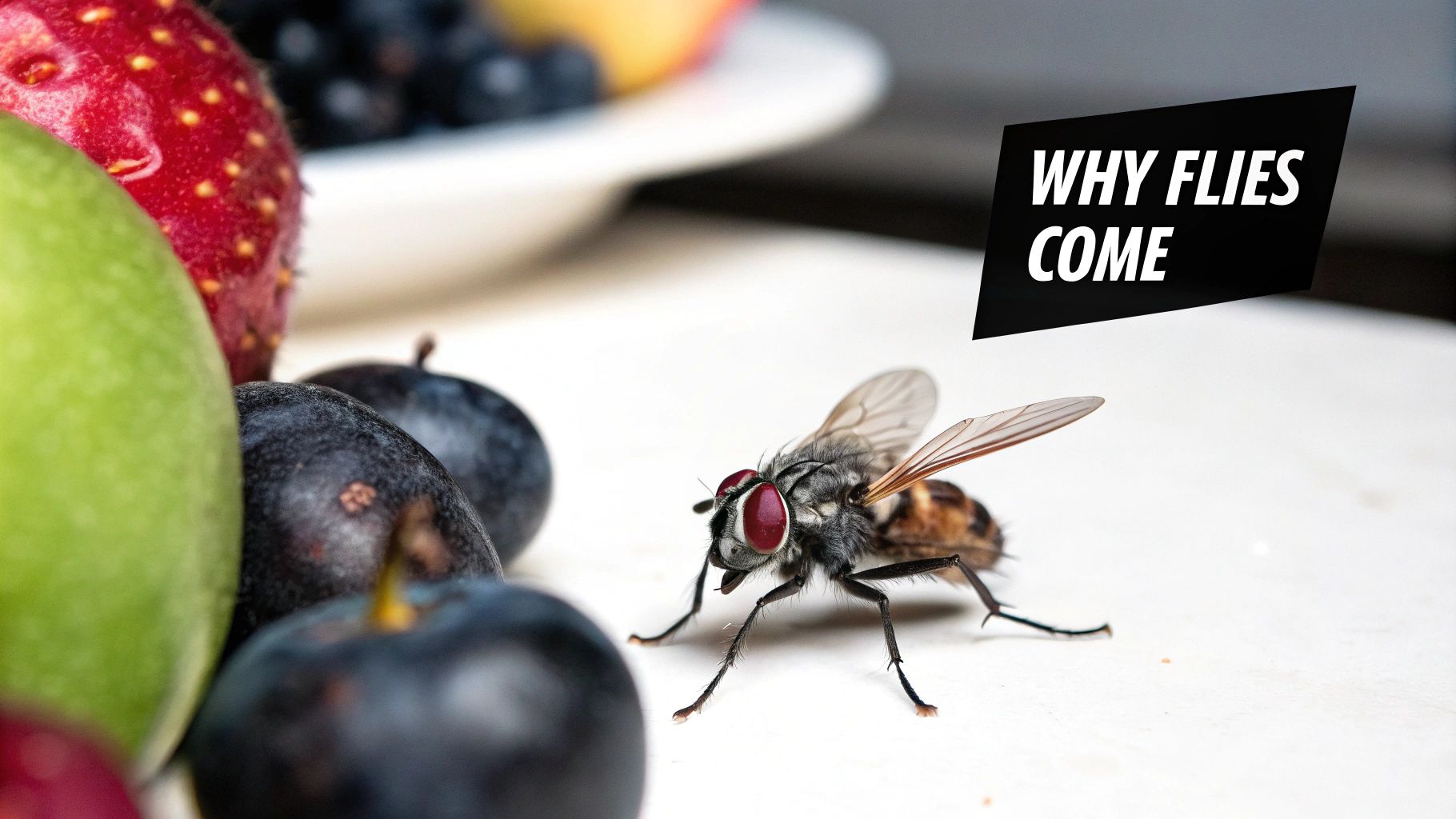
What's the secret? It's all about a fly's vision and flight mechanics. Flies have compound eyes with thousands of lenses, making them incredibly sensitive to motion and changes in their environment.
A regular fan creates chaotic, turbulent air that a determined fly can often power through. A fly repellent fan is different. It’s engineered to produce a constant, gentle vortex. This steady disruption messes with their flight sensors, making it nearly impossible to land on your plate.
It’s a smarter approach. You get a clean, scent-free solution that doesn’t clash with the aroma of your food or the vibe of your gathering.
The Science of Airflow and Safety
The genius of these fans is how they balance effectiveness with safety. The blades are intentionally soft and flexible. If they touch a hand, arm, or even a piece of food, they stop spinning instantly.
This built-in safety feature gives you total peace of mind, whether you're hosting a backyard barbecue with kids or managing a busy restaurant patio. You get all the benefits of a pest-free zone without the downsides of traditional pest control.
This hands-off, chemical-free approach is part of a bigger shift. People are actively seeking products that are not only effective but also completely safe for their families, guests, and customers.
The popularity of these devices speaks for itself. For a deeper dive into protecting your meals, check out our guide on how to keep flies away from food.
Fly repellent fans offer distinct advantages that make them the go-to choice for various situations. This table breaks down their core benefits.
Fly Repellent Fan Benefits at a Glance
| Benefit | Ideal For | Why It Works |
|---|---|---|
| Chemical-Free | Homes with kids/pets, restaurants, organic markets | No sprays, fumes, or toxins near food or loved ones. |
| Safe to Touch | Buffet tables, family dinners, catered events | Soft, flexible blades stop on contact, preventing injury. |
| Quiet Operation | Patios, hotel dining, intimate gatherings | The motor is nearly silent, so it won't disrupt conversation. |
| Portable & Cordless | Picnics, camping, outdoor catering, food trucks | Most models are battery-operated for use anywhere. |
| Effective Coverage | Standard 4-6 person dining tables, charcuterie boards | One or two fans can protect an entire spread from pests. |
Ultimately, these fans provide a simple, elegant, and highly effective solution to a common problem, enhancing any dining experience.
Mastering Placement for Full Coverage
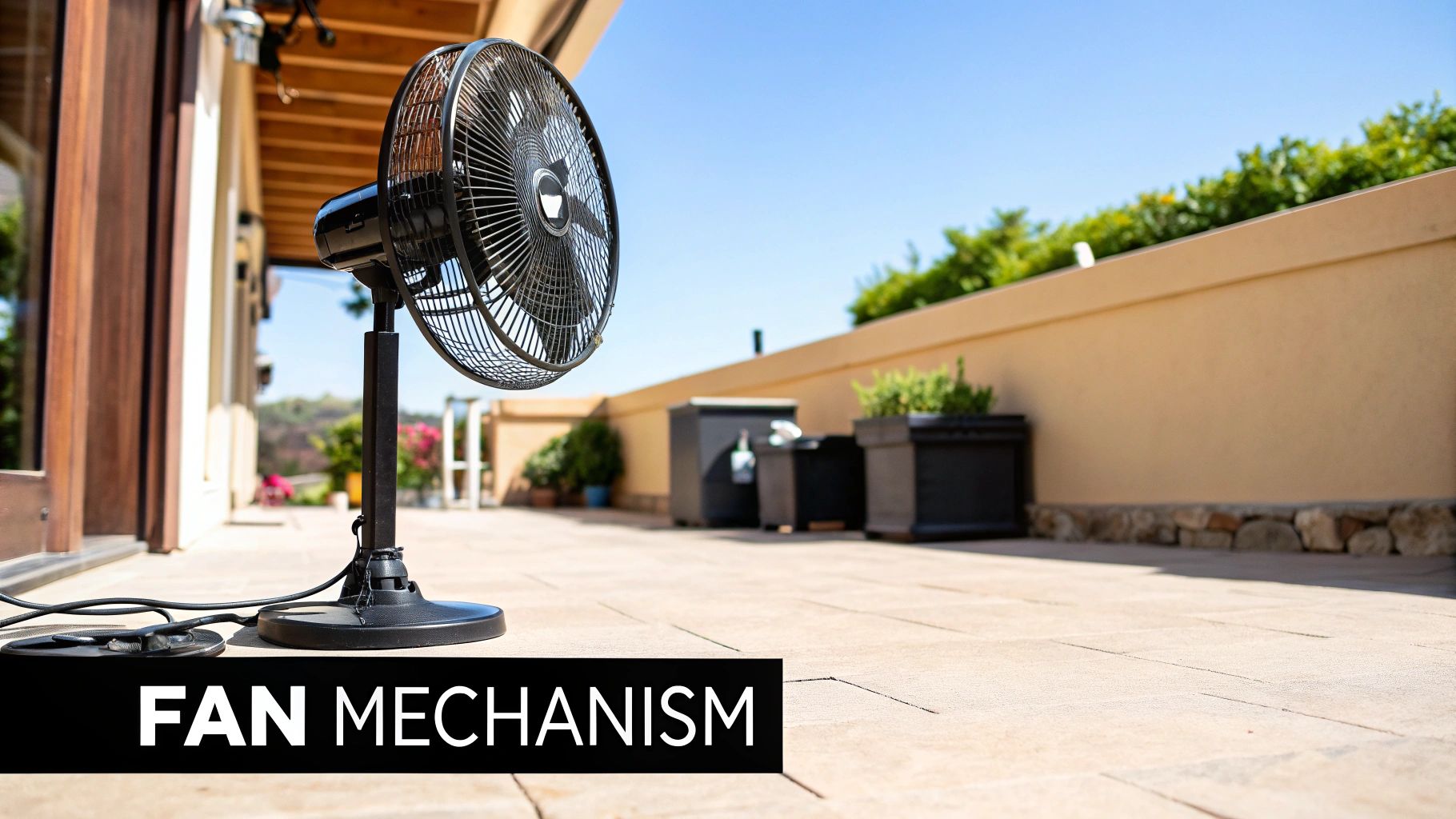
Where you put your fly repellent fan is everything. Smart placement turns a neat gadget into a genuine no-fly zone. The goal is to use the fan's air currents to create an invisible barrier that flies can't breach.
Think of each fan as projecting a protective bubble. This "coverage zone" is a consistent area of disrupted air that extends in a 2- to 3-foot radius from the fan's center. Your job is to overlap these zones to completely shield your food and guests.
Creating an Invisible Shield
For a standard four-person table, one fan in the middle usually gets the job done. But as you scale up, your strategy needs to adapt.
Take a long buffet table at an event. One fan at the end leaves the other side wide open for a fly invasion. You have to be more tactical.
- For Long Tables: Multiple fans are your best friend. The sweet spot is placing one fan about one-third of the way in from each end. This creates overlapping air currents and leaves no gaps.
- For Restaurant Patios: Give each table its own fan. It creates an individual shield, empowers diners, and stops flies from hopping between tables.
The secret is to think defensively. You're not just moving air—you're establishing a continuous line of defense that a fly’s fragile wings simply can't handle.
Real-World Placement Scenarios
Picture a classic backyard barbecue with burgers, salads, and dessert on a buffet line. That food spread is ground zero for pests.
Treat your buffet line like a high-value asset. Place at least two fans on the table, spaced out between the platters. This creates a constant airflow directly over the food, making it a terrible landing spot for any curious fly.
For a large round patio table, one fan in the center usually works for everyone. Once you master placement, you stop hoping flies stay away and start actively ensuring they do.
Perfecting Your Setup for Any Event
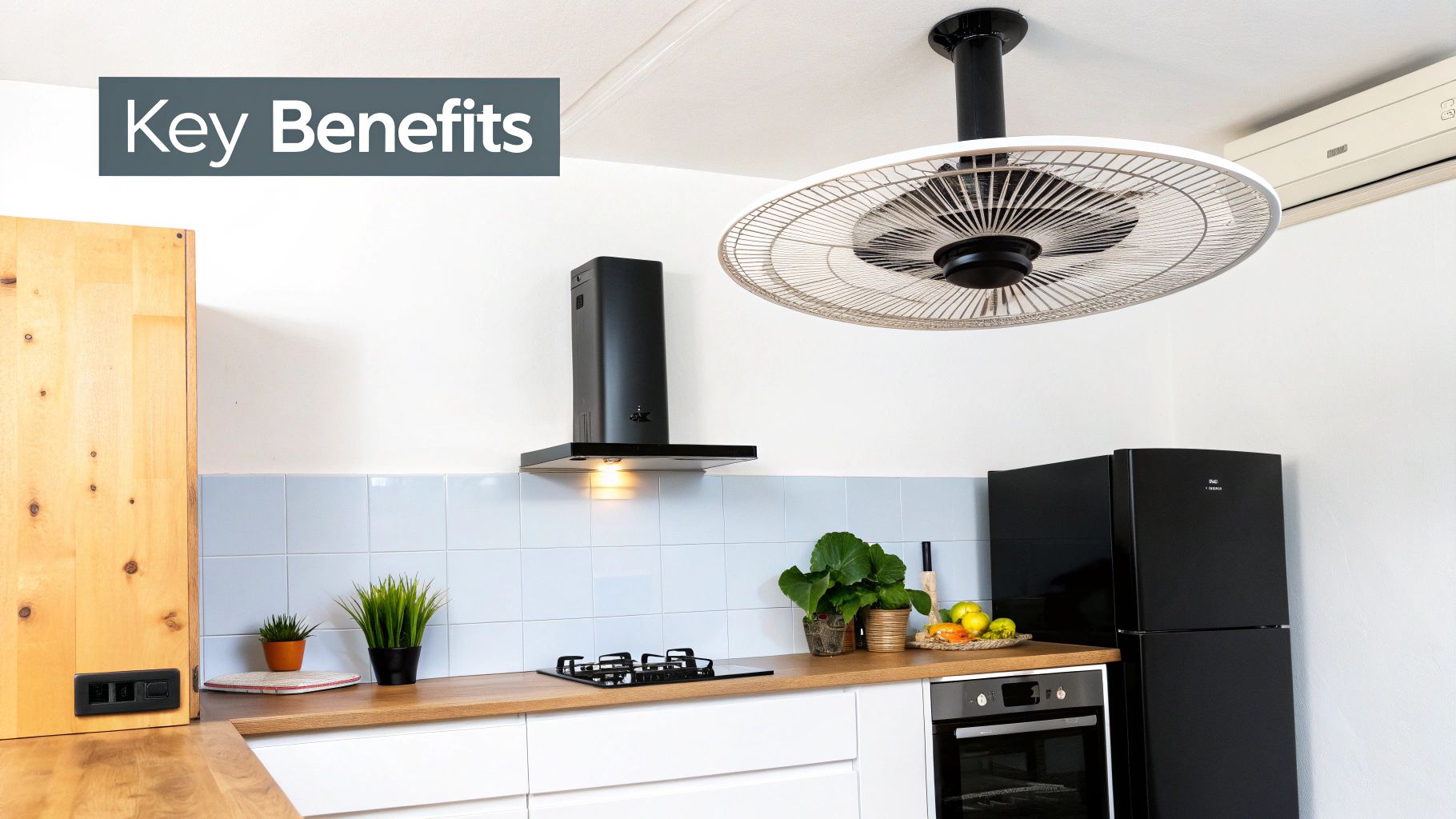
Getting your fly repellent fan setup right is a game-changer, whether you're managing a busy hotel brunch or hosting a few friends for a BBQ. A good fan is your secret weapon against pests, but its real power comes from smart preparation. It's not just about where you put it; it’s about thinking ahead.
If you're in the restaurant or catering business, a dead battery mid-service is your worst enemy. Battery management must be a priority. We recommend having two sets of fully charged batteries for every fan. Keep one set in the fan and the other on the charger, ready for a quick swap without interrupting anyone's meal.
Tailoring Your Approach
A professional caterer and a home host will use these fans differently. Here’s how to fine-tune your strategy for both.
- For Commercial Venues: Consistency is key. Stick to one fan model for a uniform, professional look. Before any event, test every unit. It takes minutes but prevents the headache of discovering a dead fan during the dinner rush.
- For Home Gatherings: This is all about safety and simplicity. Place fans where they’re less likely to be knocked over by kids or pets. It's also smart to remind curious kids that while the blades are safe, the fans work best when left alone.
Pro Tip: Treat your fan setup like a pre-flight check. A few moments spent checking batteries and placement guarantees a smooth, pest-free event for you and your guests.
The demand for effective, non-chemical pest solutions is rising. According to recent industry reports, the market continues to grow as more people become aware of the health risks from flies.
Choosing the Right Fly Repellent Fan
Not all fly repellent fans are created equal. The key to finding the right one is to think about how you’ll use it. The needs of a bustling restaurant patio are a world away from a quiet family picnic.
A commercial venue needs something durable that runs for hours, while a homeowner hosting a BBQ cares more about portability and quiet operation.
This visual shows how these fans stack up against other common methods.
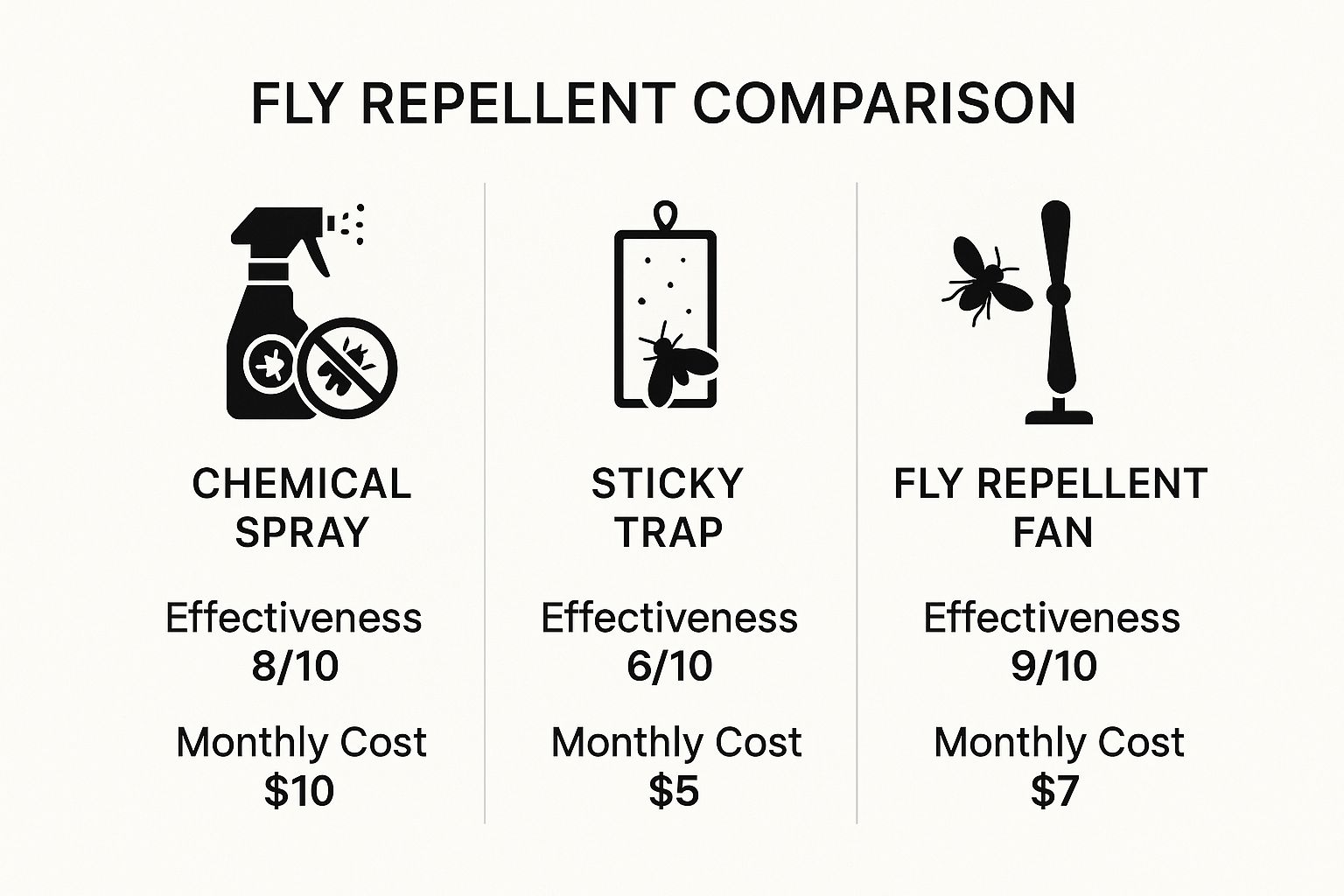
As you can see, fly repellent fans deliver the same high effectiveness as chemical sprays but without the harsh ingredients and at a lower long-term cost. It’s a clear win.
What Really Matters When You're Buying
When you start comparing fans, a few key features will make all the difference in your daily experience.
- Power Source: Think convenience. Are you heading camping where AA batteries make the most sense? Or will the fan live on your patio, where a USB rechargeable model is more eco-friendly and cost-effective? For frequent use, rechargeable units almost always pay for themselves.
- Safety Blades: This is a big one, especially with kids or at busy events. Look for models with soft-stop technology. The blades are soft, flexible, and designed to stop instantly if they touch anything—like a hand reaching for a chip. It's a must-have feature.
- Portability and Placement: A fan with a sturdy base is essential for any tabletop. But the most versatile models also have a hook on the bottom. This simple feature lets you hang the fan from an umbrella, tent pole, or pergola for excellent overhead protection.
To see these features in action, check out our guide to the best fly repellent fan models.
Comparison of Fly Repellent Fan Types
Choosing between models can be tricky. This table breaks down the common types to help you match a fan to your specific needs.
| Feature | Battery-Operated | USB Rechargeable | Hanging Models |
|---|---|---|---|
| Best For | Picnics, camping, occasional use | Patios, restaurants, frequent use | Tents, umbrellas, overhead coverage |
| Power Source | AA Batteries | Built-in rechargeable battery (USB) | Varies (Battery or USB) |
| Portability | Excellent | Very Good | Good (Mounting-dependent) |
| Long-Term Cost | Higher (battery replacement) | Lower | Varies by power source |
The best fan is one that feels like a natural part of your setup—you turn it on and forget it's there.
The goal is to find a fan that seamlessly fits your routine. A durable, rechargeable fan is a smart investment for a restaurant, while a lightweight battery model is perfect for a spontaneous picnic.
Simple Maintenance and Troubleshooting
To get years of service from your fly repellent fan, a little upkeep goes a long way. Think of it like any other piece of gear—a quick check-up ensures it’s ready to perform when you need it.
The good news is that maintenance is incredibly straightforward. You don't need special tools or a lot of time, just a few simple habits to protect your investment.
Keeping Your Fan in Top Shape
Your number one task is wiping down the blades. After an evening on the patio or a weekend barbecue, the blades will collect dust and pollen. Just use a soft, damp cloth to give them a quick wipe. Avoid harsh chemical cleaners, as they can degrade the reflective material or damage the plastic.
Next, check the power source. If your fan uses disposable batteries, open the compartment to check for corrosion. And here's a key tip: if you're storing the fan for the winter, always remove the batteries. This simple step prevents them from leaking and ruining the device.
A well-maintained fly repellent fan is a reliable one. Taking a few minutes to clean the blades and check the power source is the best thing you can do to ensure it works perfectly next season.
Common Problems and Quick Fixes
Even reliable gadgets have hiccups. Luckily, the fixes for these fans are usually simple.
-
Fan Seems Slow or Weak: This is almost always a power issue. Your first move should be to swap in fresh, high-quality batteries. For rechargeable models, make sure it's fully charged. A low battery is the most common reason for sluggish blades.
-
Blades Won't Restart After Being Stopped: The soft-stop feature halts the blades instantly on contact. If they don't spin up on their own once the path is clear, don't worry. A gentle push on one of the blades is usually all it takes to get them going again.
The growing popularity of these devices is part of a bigger picture. The U.S. insect repellent market accounted for around $376.9 million in 2024, and with significant growth expected, it's clear people want solutions that work. You can dig deeper into consumer habits and market trends in pest control at GrandViewResearch.com.
Got Questions About Fly Fans? We’ve Got Answers.
Even with the best tips, a few questions always come up. Let's tackle the most common ones so you can set up your fly-free zone with total confidence.
This is the practical, straightforward information you need to get started.
How Many Fans Should I Use on My Table?
For a standard square or round table seating four people, one fan is usually enough. Place it in the middle to create an air barrier that covers the whole surface.
For a longer rectangular table for six or eight, use two fans. Place each one about a third of the way in from each end. This creates an overlapping field of air with no gaps for flies to sneak through.
Are the Blades Actually Safe?
Yes, they are completely safe. This is a top concern, especially for those with kids or pets. The blades are made from a soft, flexible material that can't hurt you.
More importantly, they feature "soft-stop" technology. The moment a blade touches anything—a hand, a finger, a pet's nose—it immediately stops spinning. It restarts automatically once the path is clear, making them worry-free for busy tables.
The soft-stop feature is a game-changer. It means the fan is tough on flies but gentle on people, giving you total peace of mind.
Can I Use a Fly Fan Indoors?
Absolutely. While they're perfect for patios and picnics, they are also fantastic indoors. Use one in the kitchen near an open window or back door to keep flies off your food while you prep.
It’s a great way to handle indoor pests without resorting to chemical sprays or sticky traps, keeping your air clean and odor-free.
Do They Work on Mosquitoes?
These fans are designed specifically to deter flies. The gentle air current is calibrated to disrupt a fly’s sensitive wings and navigation, making it impossible for them to land.
While the air movement might annoy a few mosquitoes or gnats, these fans aren't an all-purpose insect repellent. If you have a serious mosquito problem, you'll still want a solution designed specifically for them. Think of this as your specialist tool for winning the war against flies.
Ready to create your own fly-free zone? The MODERN LYFE collection offers the perfect blend of style and function to protect your meals and impress your guests. Discover our elegant and effective fly repellent fans at https://modernlyfe.com.

